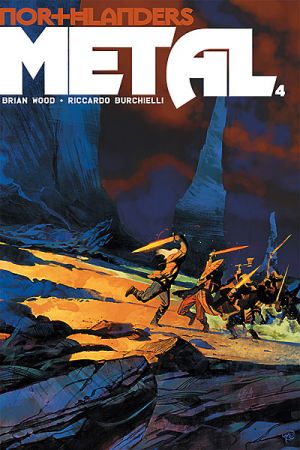- Comics
- Comics Reviews
- Manga
- Comics Reviews
- European Comics
- News
- Comics News
- Press Releases
- Columns
- Spotlight
- Digital Comics
- Webcomics
- Cult Favorite
- Back Issues
- Webcomics
- Movies
- Toys
- Store
- More
- About
By Andy Frisk
October 20, 2010 - 14:08
In Brian Wood’s story arc “The Cross and The Hammer,” Irish insurgent Magnus traveled the Irish countryside killing Norsemen en masse in an effort to drive them from his native land. He travelled with what appeared to be his young daughter, whom he battled to keep safe, but who turned out to be a figment of his tortured mind. In reality she was already an adult who made peace with her past, and even married into a Norse family. Magus met his fate at the hands of the Norsemen while The Battle of Clontarf raged and the Norsemen were driven, at least temporarily, from Ireland. Magnus was fighting to redeem himself more than anything else for abandoning his wife and daughter years ago, and imagined Brigid as a child needing his protection.
In “Metal” Erik, a hulking Norwegian blacksmith, wages a one man war of insurgency against the economic, religious, and cultural invasion of his native land, Norway, by Christian missionaries. His companion is Ingrid. She’s an albino Norwegian girl who was forced into serving as a nun, but defines herself as a seidkona (a Norse-religion witch), perhaps a bit facetiously. Her culture though believes that an albino is a “natural shaman,” and Ingrid does see the Norse goddess Hulda (who is, in short, an Earth goddess of sorts) in her dreams much like Erik does. In fact, Erik believes Hulda to be the driving force commanding him to slaughter the Christians. So far into this storyline, (which like every one proceeding it, is fantastic) I believed that the visions of the goddess Hulda were inspired by Erik’s tormented state of mind and were also a figment of Ingrid’s mass (or shared) hallucination with Erik, similar to the vision of Brigid that Magnus carried with him for so long during his campaign against the Norsemen. Enter Black Karl, a Norse mercenary who is hunting Erik and Ingrid at the behest (and payment) of the Christians. When he runs across the pair and is soundly defeated by Erik, Ingrid performs a little magical ritual that is supposed to keep him bound to the ground with metal spikes. Karl breaks free, but quickly stabs himself in the chest, apparently dies, is buried by some passing travelers, and ends up rising from his grave as a draugr (a sort of catch-all Norse word for vampire, ghost, zombie, etc.). Now, I wonder if Brian Wood is really going full on supernatural on us…
 |
One of the strengths of Northlanders has been its rigid adherence to its biting realism. Another has been its awareness of the cyclical nature of human history. There’s no thunder gods or conniving tricksters running around tossing lighting bolts at one another. As “Metal” progresses though, it looks more and more like goddesses and draugrs are being treated as real…or so it seems. It’s entirely possible that all of the events of the tale are taking place in the mind of Erik as he remains chained, as shown in the first installment of “Metal,” awaiting sentencing for his first insurgent actions. Maybe the entire episode will be revealed to be a fever dream. Maybe it is all still in Erik and Ingrid’s imagination, and they are seeing Hulda and Black Karl, the draugr, as figments of such. It seems that every day people are seeing images of Christ in either cherry tree limbs or loafs of bread, so perhaps the story, which is being told from Erik’s perspective, is simply portraying what Erik believes he is seeing. Either way it’s still an interesting, intelligent, and relevant tale that, again like all of the masterful tales Wood has crafted thus far in Northlanders, holds a mirror up to our own society and its social, religious, economic, and political conflicts (and delusions). Maybe Wood has envisioned this tale as a tribute to, or as inspired by, Norwegian metal (as in music) that often focuses on such themes as contained herein. I’m not sure if Wood is a metal music fan, so that’s just pure speculation on my part, but it is a pretty cool idea nonetheless…and the cover to the first issue of the story arc did look like the cover of a metal band’s CD…
Riccardo Burchielli continues to bring to life Erika and Ingrid’s adventures. As stated in my look at issue #30 of Northlanders, Burchielli continues to be one of a lengthening line of superb artists who have worked on Northlanders which includes Leandro Fernandez and Davide Gianfelice, all of which are similar in style, but have their own unique way of recreating facial expressions. Burchielli’s somewhat unreal and strangely distorted visages in “Metal” may be a clue as to the nature of the reality or unreality of this tale.
Overall, I still really look forward to Northlanders each month. The week it is published it sits on the top of my reading pile, and is one of the rare monthly books I read that often gets the privilege of being read twice. Several great Vertigo series have unfortunately folded, but thankfully (and justly) Northlanders soldiers on, to the benefit of all comic readers who appreciate a book that is a cut above the field.
Rating: 9 /10